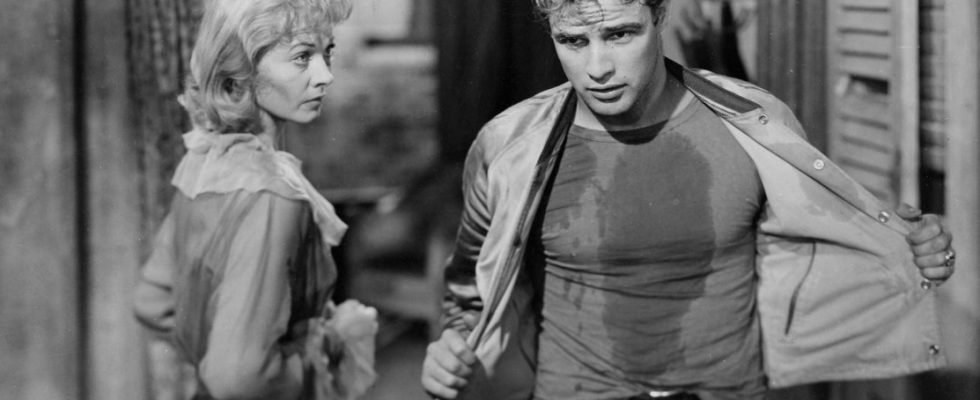100 years also pass in 100 seconds: If you look for Marlon Brando today, you will find many film snippets on YouTube, Tiktok or The Internet is full of best-of videos and memes, particularly popular are his leather jacket appearance in “The Wild One”, the hamster cheeks number from “The Godfather” or his late Appearing in “Apocalypse Now”. And of course the monologue of the century from the dockworker drama “On The Waterfront” (“The fist in the neck”): “I coulda have class, I coulda been a contender. I could’ve been somebody, instead of a bum, which is what I am.”
But of course this man became something: a man of class, not a common scoundrel as claimed. Marlon Brando, considered the best actor of his time, would have turned 100 on April 3rd. (He died in the summer of 2004 at the age of 80.) The Munich Film Museum is dedicating the most detailed retrospective of the current season to the master of method acting.
All the films mentioned above (and a few more) can be seen, of course in full length. In the case of Francis Ford Coppola’s “Apocalypse Now” it’s even extended: When the masterpiece about the madness of the Vietnam War was released in cinemas in 1979, it was almost 50 minutes shorter than the “Redux” version released in 2001. In 2019, Coppola released another version: “Apocalypse Now: Final Cut” was digitally restored and provided with new Dolby Surround sound effects; this version is shown at the Film Museum. “Horror and moral terror are your friends,” says Colonel Kurtz, played by Brando, who has long since descended into the heart of darkness.
Marlon Brando was born and raised in the Midwest, Nebraska and Illinois. He took acting lessons in New York and made his Broadway debut at the age of 20. Five years later he played his first leading film role in the war return drama “The Men”.
Marlon Brando alongside Teresa Wright in his first leading film role: The war return drama “The Men” will be shown as part of the retrospective.
(Photo: Park Circus/Filmmuseum Munich)
In the following years he became a star with films such as “A Streetcar Named Desire”, “Viva Zapata” and “On the Waterfront”. He won his first Oscar and was celebrated as a representative of a new generation of actors for his virility and sensitivity. “It was as if an alien head had been transplanted onto this muscular body, like a fake photograph,” wrote Truman Capote in his famous portrait of Brando, praising his “angelic features” and sweaty masculinity. The writer visited the actor in Japan during the filming of the film “Sayonara” (1957). At a dinner he elicited intimate confessions; the star spoke about his inability to love and his alcoholic mother. “I’ll kill him,” Brando is said to have said after Capote’s portrait appeared in the New Yorker.
There are still many books about Brando, but the one by Jörg Fauser (“The Silver-plated Rebel”) is very interesting, which not only described the existence of a film star, but also life in the USA in the post-war decades – including racism and unequal treatment. Marlon Brando was a torn man, as was Fauser, who died young and under unclear circumstances. Working with the star actor was probably tedious; his moods and alleged inability to remember script texts regularly caused shooting schedules and budgets to collapse. In 1962 he filmed “Mutiny on the Bounty,” which you read a lot of horror stories about. The director had to be replaced and the producing studio MGM ran into financial difficulties. This box office flop was still a win for Brando: he fell in love with his colleague Tarita Teriipaia, had two children with her and bought a South Sea island near Tahiti, where he was to spend a lot of time from then on. But his private life, marked by numerous affairs and severe strokes of fate, did not get any easier.
The Munich Film Museum shows 28 films
There are a total of 28 films on the Film Museum schedule, the Brando Retro runs until the end of June. It begins on March 30th with the documentary “Brando” (2007), in which companions such as Bernardo Bertolucci, Ellen Adler, Arthur Penn, Jane Fonda and Johnny Depp have their say. Marlon Brando’s only directorial work, the 1961 western “One-Eyed Jacks” (“The Possessed”), will also be shown. Some films are missing, such as “The Teahouse of the August Moon” or “Freshman”, which is hardly surprising given a career spanning more than 50 years.
Classics such as the controversial “Ultimo tango a Parigi” (“The Last Tango in Paris”) or “The Godfather”, which was also created in 1972, are also shown, as is the obscure western “The Missouri Breaks” (“Duel on the Missouri”) from 1976, in which he hunts a horse thief (Jack Nicholson) as a killer in drag. Bernhard Wicki’s only film shot in Hollywood, “Morituri” (1965) and Charles Chaplin’s last feature film “A Countess from Hong Kong” are also on the program: in this hopelessly old-fashioned comedy, Brando was discovered in 1967 On a ship voyage, a stowaway (Sophia Loren) is found in the closet of his cabin. “What are you doing in that closet,” he asks her, completely taken by surprise. It’s a completely different Brando than the one from the best-of clips. So it’s worth opening even more doors in the Brando cosmos.

